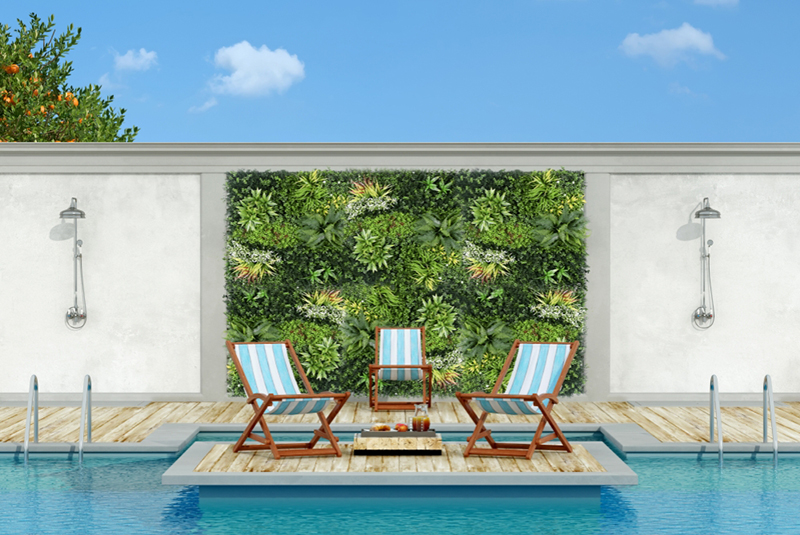Three-Dimensional Planting Patterns for 3D Artificial Vertical Gardens: Maximizing Space and Visual Impact with Layered Greenery
Artificial vertical gardens thrive when designed with three-dimensional planting patterns that mimic the natural layering of ecosystems. Unlike traditional flat wall installations, 3D designs incorporate depth, texture, and varying heights to create immersive displays that engage viewers from multiple angles. By strategically arranging plants in tiers, clusters, and cascading formations, these gardens can transform bland walls into dynamic landscapes. Below are key approaches to achieving striking 3D effects in artificial vertical gardens without relying on real plants.

Tiered planting involves organizing artificial plants into distinct horizontal layers, each with its own height and texture. This method creates a sense of progression and guides the eye upward or downward, enhancing the garden’s perceived scale.
Upper Tier for Bold Focal Points: Place larger, more visually striking artificial plants, such as those inspired by broad-leaved philodendrons or monstera, at the top of the garden. These designs act as anchors, drawing attention and adding drama to the overall composition.
Middle Tier for Volume and Balance: Fill the central section with medium-sized artificial plants, like those resembling ferns, calatheas, or smaller palms, to create a sense of fullness. This layer connects the upper and lower tiers, ensuring a cohesive and balanced look.
Lower Tier for Grounding and Detail: Use shorter artificial plants, such as those mimicking succulents, creeping thyme, or moss, at the base of the garden. These designs add a sense of stability and intimacy, making the display feel more approachable.
Cluster planting groups artificial plants of similar species or textures together to create pockets of visual interest. This approach mimics how plants grow in nature, where certain species tend to dominate specific areas.
Monochromatic Clusters for Bold Statements: Arrange artificial plants with similar leaf shapes or colors in tight groups, such as clusters of faux ferns or variegated ivy. These monochromatic displays create a striking impact and work well as accent features within the garden.
Mixed-Texture Clusters for Organic Complexity: Combine artificial plants with different leaf textures, such as pairing smooth-leaved pothos with feathery asparagus ferns, to add depth and realism. These mixed clusters break up monotony and make the garden feel more dynamic.
Size-Varied Clusters for Visual Hierarchy: Group artificial plants of varying heights and sizes together, such as placing tall snake plants alongside shorter sedums, to create a sense of natural randomness. This technique adds movement and prevents the garden from looking too uniform.
Cascading planting involves letting artificial plants spill over the edges of the garden or drape downward from higher tiers. This method softens hard lines and adds a sense of motion, making the display feel alive.
Long, Trailing Vines for Dramatic Drops: Use artificial plants with long, flexible stems, such as those inspired by English ivy, pothos, or creeping fig, to create sweeping cascades. These designs work well when placed at the top or sides of the garden, where they can hang freely and frame the display.
Layered Cascades for Textured Waterfalls: Combine multiple types of artificial trailing plants, such as mixing fern fronds with broad-leaved vines, to create a layered effect. This approach mimics the look of a natural waterfall and adds visual richness to the garden.
Intermittent Cascades for Rhythmic Patterns: Space out cascading artificial plants at irregular intervals to create a sense of rhythm and flow. This technique prevents the garden from feeling too heavy and guides the viewer’s eye through the display.
To achieve a truly three-dimensional effect, artificial vertical gardens can combine vertical growth patterns with horizontal spread. This hybrid approach ensures the garden looks engaging from all angles, not just head-on.
Vertical Accents for Height and Structure: Incorporate artificial plants with upright growth habits, such as those resembling snake plants, dracaenas, or cordylines, to add height and vertical interest. These designs break up horizontal lines and create a sense of upward movement.
Horizontal Spreaders for Width and Fullness: Use artificial plants with spreading growth habits, such as those mimicking creeping jenny or ice plants, to fill out the garden horizontally. These designs add width and make the display feel more expansive.
Diagonal Elements for Dynamic Energy: Introduce artificial plants with angled stems or leaves, such as those inspired by certain grasses or bromeliads, to add a sense of diagonal movement. This technique injects energy into the garden and prevents it from feeling static.
By experimenting with tiered arrangements, clustered groupings, cascading designs, and multi-directional elements, artificial 3D vertical gardens can achieve a level of depth and realism that rivals natural ecosystems. These planting patterns not only enhance visual appeal but also allow for creative expression, making each garden a unique work of art.
Contact: Amy
Phone: 86-15311787313
E-mail: info@foszmac.com
Whatsapp:86-15311787313
Add: Fengtai District, Dacheng Road, No.24 Building, Room 203, Beijing, China